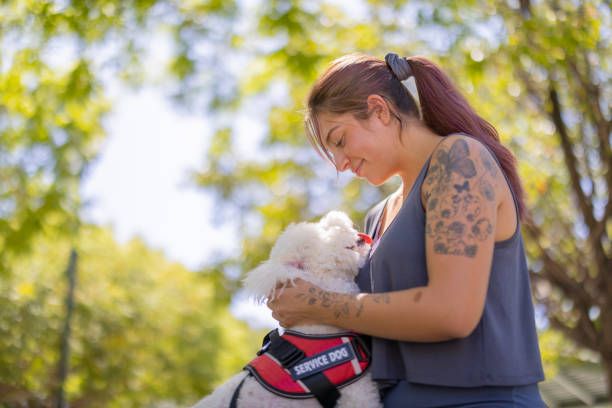This list provides examples of the most common service tasks we train at Good Human Dog Training. Because one person’s disabilities can differ from another, every task we train is customized to support the handler’s individual needs.
For a dog to be considered a Service Dog under the ADA, the tasks it is trained to perform must be directly related to and mitigate its handler’s disabilities.
Service Dog Skills
MOBILITY SUPPORT SKILLS
Dogs specializing in mobility support skills are specially trained to help people with a physical impairment that affects how well they can move around. People requiring mobility tasks or bracing may or may not be ambulatory.
- Open and close doors, cabinets, and drawers
- Hold doors open so that the handler can pass through
- Turning lights on and off
- Unload groceries from sacks
- Load and unload laundry
- Tug clothing to help with removal (outerwear, socks)
- Deposit garbage into a can
- Drop recycling into bin
- Put items onto a countertop
- Get items off a grocery shelf
- Place items into the cart
- Carry items in a bucket
- Carry bags in from a store
- Deliver item from cashier to handler
- Pull a cord to open curtains
- Provide momentum assistance
- Serve as a counterbalance or assist the handler in walking in a straight line to avoid bumping into things.
- Maintain balance when handler feels weak, dizzy, or if they are prone to falling.
- Provide physical support by maintaining balance when their owner feels weak, dizzy, or if they are prone to falling.
- Assist their owner in standing up or remaining upright by physically bracing them or pushing and pulling them.
- Nudge a paralyzed arm or leg into a secure position
- Assist handler with position changes (like sitting to standing)
- Assist handler in and out of pool, bathtub, or shower
- Assist handler in a public restroom
- Brace to help fallen handler regain balance
- Brace up or down stairs
- Assist with position changes (sit to stand, lay to sit, etc.)
* Good Human Dog Training does not train for significant weight-bearing tasks. See below for more info.
RETRIEVAL/HOLD SKILLS
Retrieval/Hold skills are typically used by someone with impaired mobility but may also be used for other disabilities, such as medication retrieval during a medical crisis.
- Retrieve dropped items
- Retrieve personal items and bring them to you (keys, cell phones, shoes, etc.)
- Retrieve medication or self-care kit from a designated spot
- Retrieve a beverage or snack from a designated spot
- Retrieve mail or newspaper
- Retrieve medical equipment and mobility aids (wheelchair, cane, walker, grabber, etc.)
- Carry books or supplies in a backpack
- Carry mail from mailbox to house
- Carry/deliver an item to another person
- Carry items into the house
- Carry items up/down stairs
MEDICAL AND ALERT taskS
Medical and Alert Service Dogs support people with a range of disabilities. Their dog responds to specific cues or triggers from the handler or the environment by performing a specific, trained series of behaviors.
- Lay across the chest of the handler to help reduce the duration of a seizure
- Drape along the body of the handler to assist with temperature regulation
- Lay across the chest to help the handler clear their lungs
- Provide tactile stimulation during a medical episode
- Alert caretaker or family member to a medical emergency
- Call 911 or a designated emergency person via a K9 Safety Phone
- Alert handler to changes in blood sugar
- Alert handler or caretaker to the presence of a deadly allergen
- Wake handler if an alarm is turned off
- Assist in getting up from the floor or chair after a medical event
- Assist in sitting or laying down in cases of impeding medical event
- Reassure during a medical episode
- Reorient after medical episode
- Stay with handler until help arrives
- Nudge an unconscious handler into the recovery position
- Burrow under the legs of an unconscious handler to raise blood pressure
* Good Human Dog Training does not train seizure ALERT. See below for more info.
PSYCHIATRIC SERVICE TASKs
Your service dog may also learn psychiatric service tasks for individuals with a mental health condition or developmental disability, including (but not limited to) PTSD, extreme anxiety/stress, OCD, and depression, and can help reduce suicidal ideation.
- Apply Deep Pressure Therapy to relax a handler experiencing debilitating stress levels, depression, or a flashback.
- Provide tactile grounding
- Interrupt dissociative episodes or flashbacks
- Alert handler or caretaker to escalating emotion
- Provide a “reality check” so the handler can verify hallucinations aren’t present
- Provide routine reminders (feed dog, take medication, eat meals, go to sleep)
- Interrupt repetitive or maladaptive behaviors
- Wake a handler having nightmares
- Find a specific person and lead them to the handler
- Provide a positional buffer in busy, public locations
- Block a dissociated handler from going through doors
- Find and lead the handler to a quiet place or an exit.
- Alert the handler to a person coming from behind
- Provide an excuse to leave an uncomfortable social situation
HEARING TASKS
Dogs who learn Hearing Tasks assist handlers who are d/Deaf and hard of hearing by alerting to specific sounds. Hearing dogs are typically trained to make physical contact with their handlers and lead them to the source of a sound.
- Alert handler to specific, trained environmental sounds (alarm clock, knocking, baby crying)
- Alert handler to fire alarm or emergency sirens
- Alert handler to name being called
- Alert handler to unnoticed dropped items
- Alert handler to people waiting to be noticed
- Alert handler to a car approaching from behind
- Alert to bells in an educational setting
- The family member sends the dog to find and return with the hearing impaired handler.
Working WIth Children
Service Dogs for Children may be trained to support children with learning difficulties, ASD, or any psychiatric or medical alert tasks. Because we train service dog TEAMS, there are special considerations when training dogs for children who are not old enough to be active in the training process. We’re happy to discuss these considerations to determine if our service dog training program is a good fit for your child.
The following are not trained service tasks as defined by the ADA, but we think they are too beneficial not to mention:
- Provide a social bridge to improve interactions and relationships
- Ease difficult transitions
- Provide companionship and emotional support
- Support learning by sitting with the child as they read aloud
* What Good Human Dog Training DOES NOT train and why!
- We do not train Guide dogs for visual impairment. This rigorous training is not appropriate for our owner-training model. However, the client may be visually impaired as long as the service skills expected of the dog are not guide work.
- Significant weight-bearing tasks, position transfers, and wheelchair propulsion.
The long-term wear of the dog’s skeletal system and risk of acute injury is not something we are comfortable assuming. There are many mobility and support tasks we can train! - Good Human Dog Training DOES NOT offer seizure ALERT training. Seizure Response Dogs are NOT trained to predict seizure activity. However, some dogs may develop the ability to alert their owner of an oncoming seizure. This behavior is not guaranteed to develop or be consistent if it does develop.
- Any tasks we feel may open the unconscious or impaired handler up to risk, such as “get help” from an unknown person. Note: the ADA requires the handler to be in control of their service animal, and local leash laws should be followed. We have plenty of other support tasks to train!
- Training a service dog for protection or perceived aggression is unacceptable and does not align with Good Human’s dog training methods and training philosophy.
- Tethering a dog to a child to prevent wandering. We believe there are risks to both dog and child, and this is something we do not feel comfortable undertaking. Note: the ADA requires the handler to be in control of their service animal; however, tethering puts the animal in control of the child, violating that ADA requirement. We have some alternatives to this practice!
If you are unsure whether we can meet your needs, don’t hesitate to contact us; we will be happy to discuss your situation confidentially.



